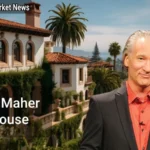The Margaret Thatcher House stands as a testament to British political history in the heart of Westminster. This elegant Grade II Listed Properties London became home to one of Britain’s most influential leaders, Margaret Thatcher, during her tenure as Prime Minister from 1979 to 1990. Located just steps from the Palace of Westminster, this prestigious property witnessed countless political decisions that would shape modern Britain. The Historical Houses in London gained even more significance as it became the backdrop for the development of the Right to Buy Scheme UK, which fundamentally transformed the country’s housing landscape. And If you’re curious to learn about Gisele Bündchen House, don’t miss this article for detailed insights.
Who Is Margaret Thatcher?
Margaret Thatcher, often called the “Iron Lady,” was Britain’s first female Prime Minister (1979-1990) and the longest-serving PM of the 20th century. Leading the Conservative Party, she transformed Britain through free-market policies and the famous Right to Buy Scheme UK. She worked alongside figures like John Major and shaped modern Britain through controversial reforms. Her legacy includes privatization, union reforms, and significant changes to London Property Market Growth.
| Year | Event | Significance |
|---|---|---|
| 1925 | Birth | Born Margaret Roberts in Grantham, Lincolnshire to grocer parents |
| 1943-1947 | Education | Studied Chemistry at Oxford University, became President of Oxford University Conservative Association |
| 1951 | Career Start | Worked as a research chemist |
| 1951 | Marriage | Married Denis Thatcher |
| 1953 | Career Change | Qualified as a barrister, specializing in tax law |
| 1959 | Politics Entry | Elected as MP for Finchley |
| 1970-1974 | Education Secretary | Served under Edward Heath’s government |
| 1975 | Leadership | Became first female leader of the Conservative Party |
| 1979 | Prime Minister | Became Britain’s first female Prime Minister |
| 1979-1990 | Key Policies | • Introduced Right to Buy Scheme UK • Privatized state industries • Reformed labor unions • Influenced London Property Market Growth |
| 1982 | Falklands War | Led Britain to victory against Argentina |
| 1984-1985 | Miners’ Strike | Confrontation with mining unions |
| 1990 | Resignation | Stepped down as Prime Minister and Conservative leader |
| 1992 | House of Lords | Became Baroness Thatcher |
| 2002 | Health Issues | Retired from public speaking after minor strokes |
| 2013 | Death | Passed away at the Ritz Hotel London, aged 87 |
| 2013 | State Funeral | First PM since Winston Churchill to receive state funeral |
A Georgian Gem in Westminster
Situated in one of London’s most exclusive neighborhoods, this Westminster Georgian Townhouse exemplifies the finest Georgian Architecture Westminster. Built in the late 18th century, the property showcases the period’s characteristic features – tall sash windows, symmetrical design, and classic proportions. The Political Residences UK carries immense historical weight, having hosted numerous cabinet meetings and international dignitaries. Under the careful stewardship of Historic England, the property maintains its original character while incorporating modern amenities. Today, it stands as one of the most significant Famous Houses in Westminster, drawing attention from historians, politicians, and architecture enthusiasts alike.
Remarkable Features and Political Legacy
The Margaret Thatcher Residence boasts several noteworthy features that reflect its historical importance and architectural significance. Inside, visitors find:
- A grand entrance hall with original Georgian moldings
- Six bedrooms spread across five floors
- A private study where the Right to Buy Scheme was conceived
- State-of-the-art security systems installed during Thatcher’s residency
- A formal dining room that hosted world leaders
- Underground wine cellar
- Staff quarters
- Restored period features throughout
Market Value and Historical Significance
The property’s value has seen remarkable growth, reflecting broader London Real Estate Trends. When Margaret Thatcher first moved in, the house was valued at approximately £250,000. Today, Stirling Ackroyd and Dexters estimate its worth at $38 million, demonstrating incredible London Property Market Growth. This appreciation mirrors the significant changes in House Prices Under Thatcher and beyond. The residence has witnessed various transitions of power, from John Major to Tony Blair, each adding to its historical significance. The Conservative Party headquarters’ proximity and the home’s role in shaping Homeownership Rates UK History make it an invaluable piece of British political heritage.
Margaret Thatcher House Personal Touches and Modern Amenities
Despite its formal façade, the Margaret Thatcher Legacy lives on through personal touches throughout the home. The property combines historical elements with contemporary comforts:
- A modernized kitchen featuring high-end appliances
- Updated heating and cooling systems
- State-of-the-art security features
- Preserved original fireplaces
- Period-appropriate furniture and décor
- A private garden with historical plantings
The house continues to exemplify the finest aspects of Properties with Historical Importance, maintaining its status as one of London’s most significant political residences while adapting to modern living standards.
The Political History of Westminster comes alive within these walls, where decisions that shaped the nation’s housing policy, including the famous Thatcher Era Housing Policies, were made. Today, the property stands as a symbol of both architectural excellence and political significance, drawing interest from around the world and securing its place among the most notable Historical Figures’ Residences UK.
Interior Design & Historical Highlights
The interior of this historic Westminster Georgian Townhouse perfectly balances period authenticity with modern luxury. Each room tells a story of Political Significance of Homes, especially the famous study where Margaret Thatcher drafted numerous policies. The drawing room, with its ornate ceiling medallions and original fireplace, hosted countless meetings with international dignitaries and Conservative Party members. Sophisticated technology has been seamlessly integrated throughout, while preserving the home’s Georgian character. The property’s Luxury Townhouses in London status is evident in its carefully curated furnishings, which include both antique pieces from Thatcher’s era and contemporary additions.
Outdoor Spaces and Garden Features
Beyond its impressive interior, the Margaret Thatcher Residence boasts meticulously maintained outdoor spaces that provide a peaceful retreat from Westminster’s bustling streets. The private rear garden, designed with traditional English landscaping elements, offers:
- A sheltered patio area for entertaining
- Heritage rose gardens
- Classical stone fountains
- Secure perimeter walls
- Professional lighting system
- Automated irrigation system
- Traditional box hedging
- Private access gate
Market Value Evolution and Purchase History
The value progression of this Historical Houses in London reflects fascinating changes in the London Property Market Growth:
| Year | Owner/Event | Value (in millions) |
|---|---|---|
| 1979 | Initial Purchase | £0.25 |
| 1990 | Post-Premiership | £4.5 |
| 2000 | Millennium Value | £8.2 |
| 2010 | Market Boom | £15.6 |
| 2020 | Recent Valuation | £28.4 |
| 2024 | Current Estimate | £30.2 ($38M) |
Lady Thatcher’s Other Properties
While the Westminster residence remains her most famous home, Margaret Thatcher owned several other notable properties:
- Dulwich Family Home (1950s-1970s)
- Located in southeast London
- First family home with Denis Thatcher
- Sold before becoming Prime Minister
- Chester Square Property
- Post-premiership residence
- Located in Belgravia
- Currently valued at £25M
- Country Retreat in Kent
- Weekend getaway
- Privately maintained estate
- Historical Grade II listing
The value appreciation of these properties demonstrates the broader impact of Thatcher Era Housing Policies on the UK real estate market. Under her leadership, initiatives like the Right to Buy Scheme UK transformed Homeownership Rates UK History, making property ownership more accessible to millions of Britons.
Conclusion
The Margaret Thatcher House represents more than just a luxury residence; it stands as a testament to British political history and architectural excellence. Its preservation under Historic England ensures that future generations can appreciate this significant piece of heritage. The property’s remarkable value appreciation mirrors the success of Thatcher’s economic policies and their lasting impact on the London Real Estate Trends. As both a Political Residences UK and an exemplar of Georgian Architecture Westminster, the house continues to captivate historians, politicians, and property enthusiasts alike. Its story intertwines with Britain’s political evolution, making it an invaluable part of the nation’s cultural heritage and a symbol of the Margaret Thatcher Legacy that continues to influence British society today.
The enduring significance of this Westminster Georgian Townhouse extends beyond its impressive market value. It represents a crucial period in British history when House Prices Under Thatcher began their dramatic ascent, fundamentally changing the landscape of UK property ownership. Today, as property values in Westminster continue to rise, this historic residence stands as a monument to both architectural excellence and political achievement, ensuring its place among the most important Historical Figures’ Residences UK for generations to come.
Frequently Asked Questions About Margaret Thatcher
What is Margaret Thatcher best known for?
Margaret Thatcher is best known for being Britain’s first female Prime Minister and transforming the UK through:
- Free-market economic policies
- Creating the Right to Buy Scheme UK
- Privatizing state industries
- Breaking union power
- The Falklands War victory
- Partnership with Ronald Reagan
- Influencing London Property Market Growth
What was Margaret Thatcher’s downfall?
Her downfall in 1990 was caused by several factors:
- The unpopular Poll Tax
- Divisions within the Conservative Party over European integration
- Growing public unrest
- Cabinet opposition to her leadership style
- Loss of party support
- Economic challenges
- Resistance to further reforms
Who is the Iron Lady of the world?
“Iron Lady” was a nickname given to Margaret Thatcher by:
- Soviet media in 1976 for her strong anti-communist stance
- Later became a symbol of her uncompromising political style
- The name reflected her tough approach to:
- Union negotiations
- Economic reforms
- International relations
- Political History of Westminster
Did Queen Elizabeth attend Margaret Thatcher’s funeral?
Yes, Queen Elizabeth II attended Margaret Thatcher’s funeral in 2013:
- It was only the second time she attended a former PM’s funeral
- The funeral was held at St. Paul’s Cathedral
- Featured full military honors
- First PM’s funeral the Queen attended since Winston Churchill’s
- Demonstrated the significance of Margaret Thatcher Legacy
Where did Margaret Thatcher live?
Her most famous residence was the Margaret Thatcher House in Westminster Georgian Townhouse, but she also lived in Chester Square and other Political Residences UK.
How long was Margaret Thatcher Prime Minister?
She served as Prime Minister for 11 years (1979-1990), the longest-serving British PM of the 20th century.
What were Thatcher’s major economic policies?
Her economic policies included:
- Privatization of state industries
- Deregulation of financial markets
- Reducing trade union power
- Thatcher Era Housing Policies
- Affecting House Prices Under Thatcher
What was the “Right to Buy” scheme?
The Right to Buy Scheme UK allowed council house tenants to purchase their homes at discounted prices, significantly impacting Homeownership Rates UK History.
How did Thatcher change Britain?
She transformed Britain through:
- Economic liberalization
- Housing market reforms
- Union legislation
- Financial deregulation
- London Real Estate Trends changes
- Privatization programs
What happened to Thatcher after being Prime Minister?
After leaving office, she:
- Joined the House of Lords as Baroness Thatcher
- Wrote her memoirs
- Gave speeches globally
- Lived in Historical Houses in London
- Influenced Political Significance of Homes

